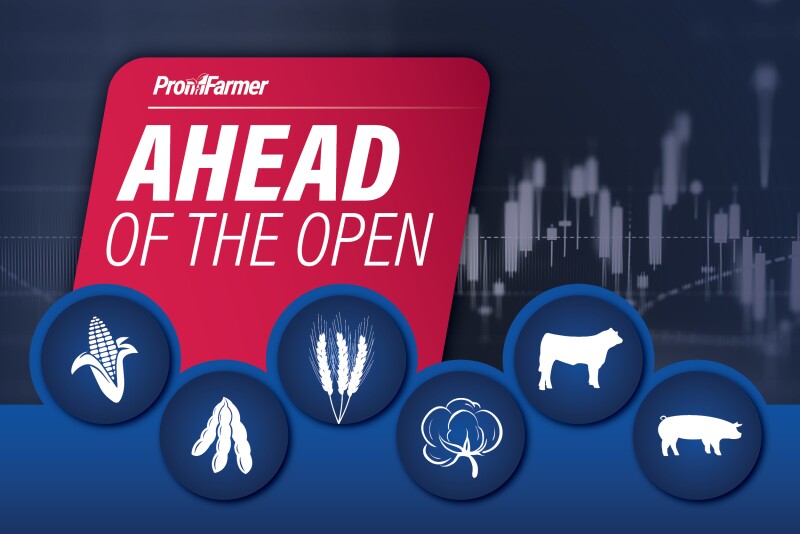GRAIN CALLS
Corn: 1 to 3 cents lower.
Soybeans: 4 to 8 cents lower.
Wheat: 4 to 8 cents lower.
GENERAL COMMENTS: Corn, soybeans and wheat faced followthrough selling to Monday’s sharp losses during the overnight session amid pressure from favorable weather and trade concerns. The selling pressure seen overnight is expected to continue this morning, with risk of those losses being extended if chart support falters as supportive news is lacking. Outside markets are quiet, with little movement in either the U.S. dollar index or crude oil futures.
USDA reported daily corn sales of 112,776 MT to Mexico for 2025-26 and 144,000 MT of soymeal to the Philippines – 97,000 MT for 2024-25 and 47,000 MT for 2025-26.
USDA rated the corn crop as 74% “good” to “excellent” and 5% “poor” to “very poor,” the soybean crop 66% “good” to “excellent” and 7% “poor” to “very poor” and the spring wheat crop 50% “good” to “excellent” and 15% “poor” to “very poor.” On the weighted Pro Farmer Crop Condition Index (CCI; 0 to 500-point scale, with 500 representing perfect), the corn crop inched up 0.6 point to 382.0 and the soybean crop improved 1.9 points to 363.7, while the spring wheat crop declined 3.8 points to 351.6. The corn crop is now rated 6.7 points above year-ago, while soybeans are still 1.7 points below last year at this time. Spring wheat is 31.9 points below last year. Click here for details.
Weather remains generally favorable for crop development. World Weather Inc. said, “Rain will continue to fall frequently over the coming 10 days and then slacken off a bit as cooler and slightly drier air arrives 10 days from now.Rain should increase again as warmer air returns a little later this month.”
Trade uncertainties continue to hang over markets as President Donald Trump continues to apply pressure to countries to sign trade deals. He signed an Executive Order officially extending the effective date on the tariffs announced April 2 to Aug. 1. However, it is not yet clear that Aug. 1 will be a hard and fast deadline. Reciprocal tariff letters were sent Monday to 14 countries, outlining new tariffs ranging from 25% to 40% set to take effect on Aug. 1 if agreements aren’t finalized. Those facing 25% tariffs include Japan, South Korea, Malaysia, Kazakhstan and Tunisia. Those facing tariffs of 30% to 36% include South Africa, Bosnia, Indonesia, Bangladesh, Serbia, Thailand and Cambodia. Those facing 40% tariffs include Myanmar and Laos. Steel and aluminum tariffs, currently set at a 50% rate as part of the Section 232 sectoral rates, will remain in place but will not stack on top of the new rates. Several other sectoral tariffs are also under investigation but have not yet taken effect.
China warned the Trump administration against reigniting trade tension by restoring tariffs on its goods next month and threatened to retaliate against nations that strike deals with the U.S. to cut China out of supply chains. China has until Aug. 12 to reach an agreement with the U.S. to avoid additional tariffs.
CORN: December corn futures posted the lowest close in the life of the contract on Monday and appear poised to challenge last week’s contract low at $4.16 3/4. Below that, bears would target the psychological $4.00 level. Resistance is layered heavily in the $4.25 to $4.40 area, where the short- and intermediate-term moving averages stand.
SOYBEANS: November soybean futures are trading near the bottom of the three-month trading range. Near-term support is at the June 27 low of $10.13 1/4, which marks the bottom of that range. Violation of that support would have bears targeting the psychological $10.00 mark. Resistance is heavily layered in the $10.28 to $10.39 range, where the short- and intermediate-term moving averages stand.
WHEAT: September SRW futures remain in the sideways trading range, though bears have the short-term upper hand. Support at the bottom of that range stands at last week’s low of $5.34 3/4. Resistance is layered from the $5.50 level to the June spike high at $5.94.
LIVESTOCK CALLS
CATTLE: Choppy/higher.
HOGS: Choppy/higher.
CATTLE: Live cattle and feeders are expected to open with a mostly firmer tone after strong gains and high-range closes Monday, as traders continue to narrow still-wide discounts to the cash market. Cash cattle prices declined only 8 cents last week, which was much less than anticipated. Cash sources signal this week’s cash trade is likely to be about steady again, especially if futures build on Monday’s gains, as packer margins are solidly in the black. But after a long span of highly negative margins, packers aren’t expected to get aggressive with cash bids. Choice wholesale beef prices firmed $1.23 to $390.98 on Monday, while Select dropped 91 cents to $377.53.
HOGS: Lean hog futures are expected to open with a mostly firmer tone in a continuation of Monday’s corrective gains, though premiums to the falling cash index could limit buyer interest. The CME lean hog index is down $1.18 to $108.33 as of July 3, the fifth straight daily decline during which it has dropped $3.69 from what appears to be the seasonal top of $112.02. Pork cutout rebounded $3.28 to $113.49 on Monday as all cuts firmed, led by an $11.18 jump in primal bellies.

